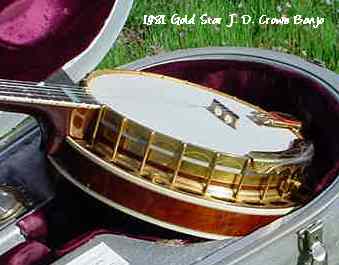 Asian Banjos - Overview
Asian Banjos - Overview
Also see Asian Banjo Catalogs.
From about 1962 on and especially since 1970 there have been a large number of oriental manufacture banjos made to answer the demand. By far and away most of these are entry level 5 string instruments, yet the basic construction for tenor, plectrum and guitar banjos is similar with a different neck and number of strings, so the information here applies to them also. Basically the importer could (and still can) specify a brand name and have it put on an banjo. There are about 6-8 levels of hardware and finish overall, ranging from a very plain wood pot (body) or cast aluminum pot to replicas of a pre WWII Gibson RB-Granada flathead Mastertone (the bluegrass holy grail largely because Earl Scruggs used one for decades, and there were only about 12-15 original 5 string ones built in 1931-34). These were the Gold Star J. D. Crowe models that were frankly better than the then current Gibson product (1981) and arguably equal or better than the originals from the 1930's. Actually, all of the Gold Stars had the best hardware available, there are some extra supernal touches in the early Gold Star J. D. Crowes.
The importer could specify what he wanted, and there were/ are at least 30 quality brands and over 100 others. The quality also varied across the product lines; there were for instance some very entry level Arias and some better Arias at the same time, sort of like Chevrolets and Cadillac Limousines. The major step in quality is usually to the Gibson Mastertone pattern of construction (Masterclone), with a cast metal tone ring (brass/bronze, steel, aluminum and pot metal all have been encountered) sitting on a wooden rim under the drumhead.
For an example of the Mastertone construction, look at the picture of the gold one above. The brown line between the gold tone ring and the resonator flange is the wooden rim. Going down in the picture, there is white drumhead, the gold tension hoop (with arches engraved between the hooks, and an engraved armrest over it on the right side of the picture), the white edge of the drumhead, the gold tone ring, the brown wood of the pot, the gold flange, the white binding on the resonator, the brown wood of the side of the resonator, white binding again, the maroon of the case lining, and the silver paint on the (fiberglass Leaf) case.
There are a large number of links on my site where you can find pictures and information on banjo adjustment in general, and Gibsons in particular. However, practically any banjo can be adjusted to sound "pretty good", and be playable. See Bill Palmer's stuff in particular. The Gibson construction is common because Scruggs, Reno, et al played one, but there have been many other quality brands built in the USA in the past and today. They are not all built in the Gibson way.
I still have a few entry quality instruments, and they sound like me when I play them. Some of my other ones of course do sound a bit sweeter..... but by far the overpowering factor is the player when it comes to producing tone.
If you have an instrument labeled made in Japan, that pretty well places it before 1990, by that time most of the manufacture had shifted to Korea. The Kasuga factory was the biggest maker of bluegrass instruments. They made numerous brands including Aria, Kasuga and Epiphone, often doing nothing but changing the logo. The Kasuga was the last factory producing banjos and mandolins in Japan and it went out of business about 1995.. Some of the hardware on quality American banjos is now Asian made (like tailpieces), and some hardware (steel armrests, coordinator rods) is even Chinese in origin.
Please do not ask me the value of an Asian banjo, including how much to buy/sell it for, saying if you got a good deal or to tell you if it is worth repairing. There are a lot of variables, and I won't/can't give you a answer. I am not in that business, and it is not something I do. If you choose to ignore this, you can send me the banjo, I will tell you my opinion of what it is worth, and I will keep the banjo as the fee for the appraisal.
I do not get into buy/sell recommendations. My views are here on this section and in The Search. The answer for you is in your hearing.
You have to play the one you are thinking of buying.. Travel to where ever it is, period. Think of it as an Odyssey. If you are impatient, it will be to your detriment both in purchase and in actually learning to play. Impatience is a prime reason 95% of people end up failing in their own assessment. This is for the long haul. The potential is there in some foreign instruments; if not properly set up, all bets are off. And there are a few clunkers in any brand, new or prewar. They are not all identical like books at Amazon.com.
Another factor, hidden in plain view, is Americans are addicted to buying things, seldom with a real cost/ benefit analysis. Impulse buying and external validations are habitual. It is a deep training starting in early childhood.
Travel. Play them. Listen. No short cuts, you make your own guarantees. That is the real answer.
This basic list came from Wayne Norman. I've added to it and commented on some of the banjos I have seen. I have broken it down into two lists, entry level through moderate quality banjos, and better quality banjos (here), which are generally replicas of the Gibson Mastertone design.
Last Updated 15 Jul 2006 by PJH
Edited 09 Feb 2018 by WF